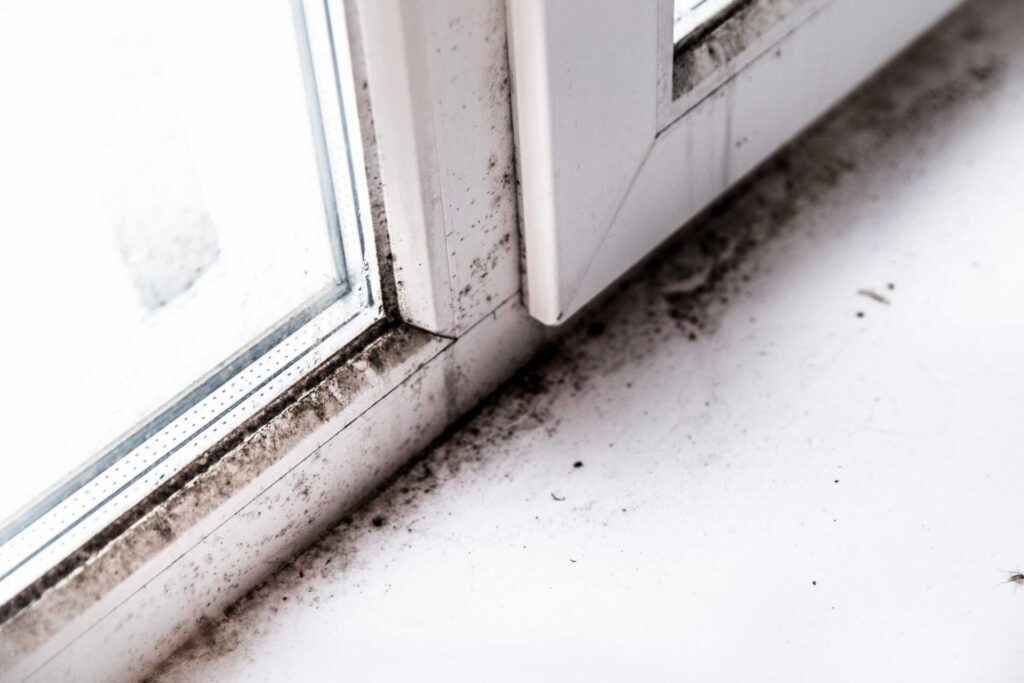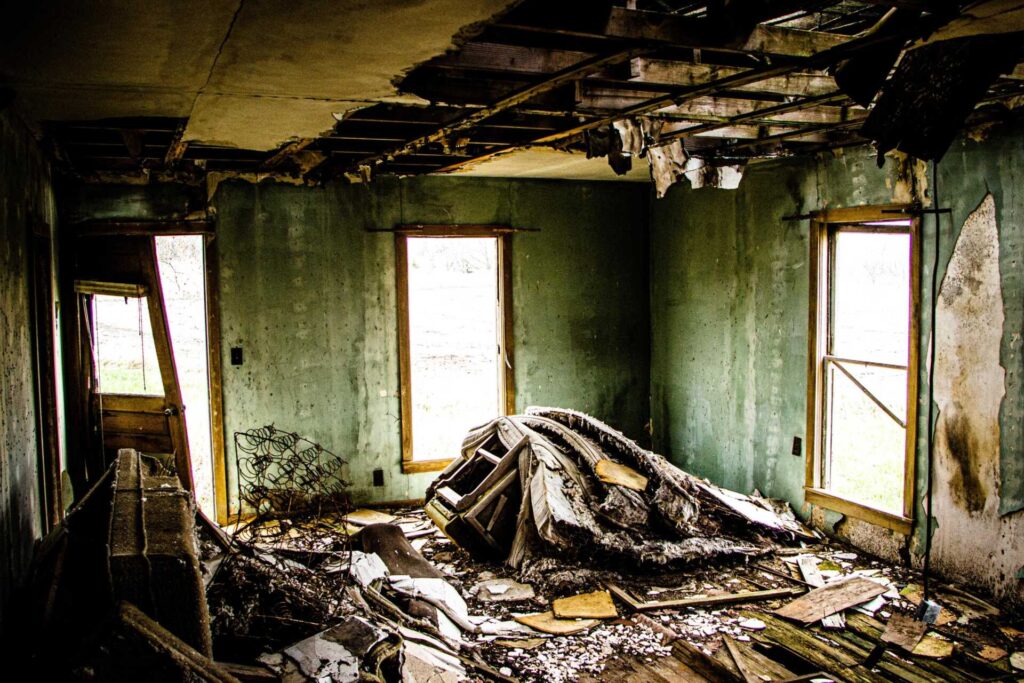
Contents
Water damage can leave your home vulnerable, but swift action can prevent mold from taking hold. By understanding the key steps in mold prevention, you can protect your living space and maintain a healthy environment. From evaluating damage to implementing long-term strategies, each action plays a vital role. Let’s explore how you can effectively manage moisture and safeguard your home against mold growth.
Key Takeaways
- Act quickly to remove standing water within 24 to 48 hours to minimize mold growth potential.
- Increase ventilation and use dehumidifiers to maintain humidity levels below 60%.
- Thoroughly dry affected areas, including hidden spaces, within 24 to 48 hours post-damage.
- Regularly monitor humidity levels with a hygrometer and take action when they exceed 60%.
- Inspect and maintain plumbing, HVAC systems, and seals around windows and doors to prevent future leaks.
Assessing the Extent of Water Damage
How can you effectively evaluate the extent of water damage in your home? Start by identifying visible signs, like discoloration on walls, ceilings, and floors.
Use your sense of smell; musty odors often indicate hidden moisture. Next, check areas around windows, pipes, and appliances, as leaks frequently occur there.
Don’t forget to inspect your basement or crawl space, where water can accumulate unnoticed.
Once you’ve identified affected areas, measure the damage’s depth. A moisture meter can help you determine how saturated materials are.
Document everything with photos for insurance purposes and future reference.
It’s essential to act swiftly; the longer you wait, the more extensive the damage could become.
By thoroughly evaluating water damage, you’re taking the first step toward preventing mold growth and protecting your home.
Immediate Water Extraction Techniques
When water damage occurs, quick action is essential to prevent mold growth.
You’ll need the right tools for effective water removal, such as pumps and wet vacuums, to address the situation promptly.
Importance of Quick Action
Since mold can begin to develop within 24 to 48 hours after water damage, taking immediate action is essential.
Quick responses limit mold growth and protect your home and health.
Here are key steps you should consider:
- Identify the source of water and stop it immediately.
- Remove standing water using available resources to reduce moisture levels.
- Ventilate the area to enhance air circulation and promote drying.
Tools for Water Removal
Effective water removal is essential for preventing mold growth after water damage, and having the right tools can make all the difference.
Start with a wet/dry vacuum to quickly extract standing water from floors and carpets. For larger areas, consider using submersible pumps; they can handle significant volumes and work efficiently.
Dehumidifiers are vital, too, as they reduce humidity levels and hasten the drying process. If you’re dealing with porous materials, like drywall, specialized drying equipment can help restore them effectively.
Finally, don’t underestimate the importance of protective gear, such as gloves and masks, to keep you safe during the cleanup.
Drying Out Affected Areas
To prevent mold growth after water damage, promptly drying out affected areas is essential. The longer moisture lingers, the greater the risk of mold developing.
Follow these steps to ensure thorough drying:
Remove standing water: Use pumps or wet vacuums to eliminate excess water.
Increase ventilation: Open windows and doors or use fans to circulate air, helping moisture evaporate.
Utilize dehumidifiers: These devices can greatly lower humidity levels, accelerating the drying process.
Don’t underestimate the importance of quick action. Aim to dry out areas within 24 to 48 hours after the damage occurs.
Inspect hidden spaces like walls, carpets, and under furniture, as moisture can hide in these locations.
By taking immediate steps, you’ll protect your property and foster a healthier environment for you and your loved ones.
Cleaning and Sanitizing Surfaces
After drying out the affected areas, the next essential step is cleaning and sanitizing surfaces to eliminate any lingering contaminants.
Begin by gathering your cleaning supplies, including a mixture of water and a mild detergent or a specialized cleaner designed for mold prevention. Use a scrub brush or sponge to thoroughly clean hard surfaces, focusing on corners and crevices where moisture might hide.
For porous materials like carpets or upholstery, consider using a steam cleaner or hiring a professional service to ensure deep cleaning.
Once you’ve cleaned the surfaces, it’s imperative to sanitize them. You can use a solution of one cup of bleach to one gallon of water, but make sure you wear gloves and a mask for safety.
Apply the solution to surfaces and let it sit for at least 10 minutes before rinsing. This process removes dirt and helps prevent mold growth, creating a healthier environment for you and your loved ones.
Using Dehumidifiers Effectively
While cleaning and sanitizing surfaces is essential, using dehumidifiers effectively can considerably enhance your efforts in preventing mold growth after water damage.
By reducing humidity levels, you create an environment that’s less favorable for mold spores to thrive. Here are some key tips to maximize your dehumidifier’s effectiveness:
Choose the Right Size: Verify your dehumidifier is appropriately sized for the space you’re treating. A unit that’s too small won’t effectively reduce moisture.
Place It Strategically: Position the dehumidifier in areas with the highest moisture, such as basements or near water-damaged surfaces.
Maintain Regularly: Clean the filters and empty the tank frequently to keep the unit running efficiently.
Monitoring Humidity Levels
How can you ensure that your environment remains inhospitable to mold? One effective way is by consistently monitoring humidity levels. Mold thrives in environments where humidity exceeds 60%. By keeping humidity levels in check, you can greatly reduce the risk of mold growth. Use a hygrometer to easily track humidity, and take action when levels rise.
Here’s a quick reference table to help you understand humidity levels and their implications:
| Humidity Level | Risk of Mold Growth | Recommended Action |
|---|---|---|
| Below 30% | Low | Maintain current settings |
| 30%-50% | Moderate | Monitor regularly |
| 50%-60% | Increased | Use dehumidifiers |
| 60%-70% | High | Increase ventilation |
| Above 70% | Very High | Act immediately to reduce humidity |
Repairing and Replacing Damaged Materials
After water damage, it’s vital to assess the extent of the damage before proceeding with repairs.
You’ll need to determine which materials can be salvaged and which must be replaced to prevent mold growth.
Choosing the right replacement materials is essential for ensuring durability and maintaining your space’s integrity.
Assessing Damage Extent
Evaluating the extent of damage following water exposure is essential for effective mold prevention and restoration. Start by examining the materials affected and determining whether they can be repaired or need replacing. This step is critical in ensuring your space remains safe and healthy.
Check for visible water stains or discoloration.
Inspect structural components like drywall, flooring, and insulation.
Evaluate the presence of lingering moisture or musty odors.
Once you identify the damaged areas, you can make informed decisions on repairs or replacements.
Choosing Replacement Materials
When replacing materials damaged by water, it’s crucial to choose options that are durable and resistant to mold growth.
Start with flooring; consider vinyl or tile, which resist moisture better than wood. For drywall, opt for moisture-resistant types specifically designed for high-humidity areas.
When it comes to insulation, fiberglass is a good choice, as it dries quickly and doesn’t support mold growth. In bathrooms and kitchens, use mold-resistant paints to protect your walls.
Finally, select cabinetry made from materials like PVC or treated wood that can withstand damp conditions.
Implementing Long-Term Prevention Strategies
While it’s crucial to address immediate water damage, implementing long-term prevention strategies is imperative for safeguarding your home against future mold growth.
You can create a healthier living environment by taking proactive measures. Here are three effective strategies to take into account:
Maintain Proper Ventilation: Confirm that your home has adequate airflow, especially in high-moisture areas like bathrooms and kitchens. Use exhaust fans and open windows when possible.
Control Humidity Levels: Keep indoor humidity below 60% by using dehumidifiers and air conditioners. Regularly check humidity levels with a hygrometer.
Regular Inspections: Routinely inspect your home for leaks, water stains, and dampness. Address any issues immediately to prevent mold from taking hold.
Wrap-Up
In the battle against mold, swift action is your best ally. By following these guidelines, you can effectively mitigate water damage and safeguard your home from future infestations. Remember, a proactive approach—like staying a step ahead of a storm—means regularly inspecting for moisture, maintaining your systems, and educating your household. Take control of your environment today, and you’ll guarantee a healthier, mold-free home tomorrow.

